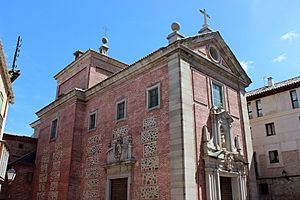Convento de la Purísima Concepción, Toledo facts for kids
The Convento de la Purísima Concepción, also known as the Convento de Capuchinas, is an old convent found in the city of Toledo, Spain. A convent is a place where a community of religious women, called nuns, live and pray.
The buildings you see today were mostly built in the late 1600s. However, the religious community here started even earlier, as an Augustinian group. The main chapel was finished and blessed in 1671. By 1677, when the convent's supporter, Cardinal Don Pascual de Aragón, passed away, most of the other buildings were also complete.
Contents
Exploring the Church Building
The church inside the convent has a unique shape. It's mostly rectangular, not like a typical cross. It has one main area, called a nave, which is split into three parts. These parts include the central area, the main chapel, and the choir section at the back.
Inside the Church: Design and Details
The nave and the main chapel have ceilings shaped like half a barrel vault, with curved openings called lunettes. In the middle, there's a dome that sits on curved supports called pendentives. The inside walls are simple and clean, with tall, flat columns called pilasters. These pilasters reach up to the decorative top parts, or cornices.
Four strong pillars hold up the dome in the center of the church. The main altar is at the very end of the church. On one side, there's a metal screen, or grille, behind which the nuns' choir is located. This choir area is wide and low, and its ceiling has a huge painting of Cardinal Pascual de Aragón's coat of arms, painted by Francisco Rizi. On the other side, there's a special chapel dedicated to Christ.
Materials and Style
The church's interior is known for its simple beauty and lack of too much decoration. Instead of lots of fancy details, it uses noble materials like marble, jaspers (a type of stone), and bronze. These materials are used for the altarpieces, picture frames, and special plaques with writings. Every part of this building shows great care and skill in its creation. It feels very balanced and well-proportioned.
Outside the Church: What It Looks Like
From the outside, the convent buildings are mostly made of brick with stone details. They have simple, blocky shapes and straight lines. This style was very common for buildings in Toledo during the 1600s.
Other Convent Buildings
Among the other buildings in the convent is a small cloister. A cloister is an open courtyard surrounded by covered walkways. This one has two floors, each with four walkways. These walkways open up to the central courtyard through rounded arches. This cloister helps connect different rooms and areas of the convent.
Artworks and Paintings
The walls of the church's main area are decorated with several important paintings:
- One painting by Simón de León Leal from 1670 shows Ferdinand III the Saint with Saint Hermenegild.
- Another painting by Carlo Francesco Nuvolone (from before 1646) shows the "Assumption of the Virgin".
- There are also two paintings from 1670: one by Giovanni Peruzzini called Santa Maria Magdalena de Pazzis, and another by Giacinto Giminiani called Apparition of the Child to Santa Rosa de Lima.
See also
 In Spanish: Convento de la Purísima Concepción (Toledo) para niños
In Spanish: Convento de la Purísima Concepción (Toledo) para niños



